Towards a Robust, Resilient Wellbeing Economy for Scotland: Report of the Advisory Group on Economic Recovery
Report from the independent Advisory Group established by the Scottish Government to advise on Scotland’s economic recovery in the wake of the COVID-19 pandemic.
2. Scotland's economic context
Prior to the coronavirus pandemic, the Scottish economy was influenced by a range of global and domestic economic and political developments over the past decade such as the global financial crisis of 2008-09, the significant fall in oil price in 2014 and the UK vote to leave the EU in 2016. These have had significant impacts on the performance of the Scottish economy and on expectations of how the Scottish economy, and sectors within it, will continue to evolve going forward.
In the year leading up to the pandemic outbreak, growth in the Scottish economy had weakened in the face of slower UK and global growth and significant uncertainty regarding Brexit, impacting on investment, trade, sentiment and output. The Scottish economy grew 0.7% in 2019, significantly below trend, while business investment had fallen 13%.
Scotland's labour market continued to perform strongly over 2019, with unemployment remaining around 4% and close to record low levels and high employment. This fed into stronger wage growth over the year, with full time gross median weekly earnings rising 2.4% over the year to £576.70: however, growth remained subdued in real terms rising 0.4%.
Annual productivity slowed to 0.5% growth in 2019, after increasing by 3.2% in 2018. Annual productivity growth can vary widely from year to year, but looking over the longer term it has grown by an average of 0.8% per year since the 2008-09 recession. Prior to the recession, from 1998 to 2007, output per hour worked increased by 1.5% per year on average. In 2018, Scotland was ranked in 16th place (out of 37 countries) for productivity levels amongst OECD countries, in the lower half of the second quartile. Scotland's international ranking within the OECD has been largely unchanged since 2007.
However, over the period since the financial crisis, growth in GDP per head was similar to that of the rest of the UK but in Scotland was driven by both increases in productivity and population whereas for the UK as a whole it was primarily driven by an increase in population from inward migration. However, inward migration is important to Scotland due to the (older) age structure of the population. This is picked up in greater detail in section 2.5.
Despite the uncertainty caused by Brexit in 2019, Scotland retained its position as second to London in attracting new Foreign Direct Investment projects in 2019 with 101 new inward investment projects being secured, up from 94 the previous year.
2.1 Scotland's economic strategy
Scotland's Economic Strategy[1] was published in 2015 and sets out the ambition to reach the top quartile of OECD countries on productivity, wellbeing, sustainability and equality. It placed an emphasis on boosting competitiveness while simultaneously tackling inequalities, and set out four priority areas: investment, innovation, internationalisation and inclusive growth.
There is growing evidence that delivering sustainable growth and addressing longstanding inequalities are reinforcing - and not competing - objectives. The OECD estimated that rising income inequality had reduced UK GDP per capita growth by 9 percentage points between 1990 and 2010[2] and the IMF notes that tackling inequality is not only a social imperative; it is critical for sustaining growth.[3]
2.2 Current economic situation
There is broad consensus that the pace and scale of collapse in economic activity is unprecedented but acknowledgement that this has occurred to protect public health.
The Scottish Government's most recent assessment of the impact on the Scottish economy by the Chief Economist in June 2020 suggests a fall in GDP in Scotland of a third over the current period of distancing and 14% over the year. The Scottish Government's scenario analysis suggests unemployment could reach 10% later in 2020.
These impacts are similar to what we might expect to see in other countries and the global economy is forecast to contract this year for the first time since the financial crisis.
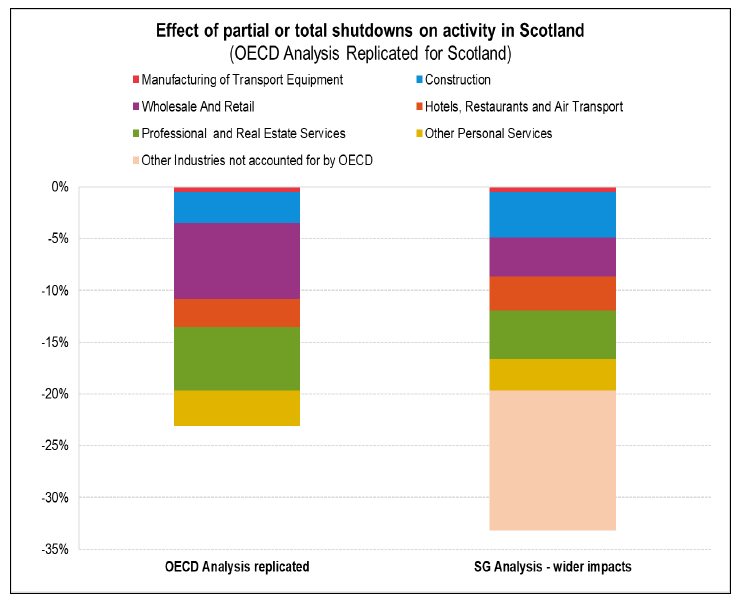
Figure 1 description
This figure shows the composition of the impact of C19 lockdown on economic activity across different sectors of the economy in Scotland. The total impact shows that replicating the industries examined by the OECD for the UK and other countries 22% of the economy in Scotland is closed. Extending this to all industries including those not examined by OCED, increases the impact to a 33% fall in activity.
The priority has been to protect public health with physical distancing measures quickly introduced to contain the spread of Covid-19. Some of these measures have necessitated the shutdown of many parts of the Scottish economy. Our economic analysis shows that 22% of the economy has been strictly closed which has impacted over 900,000 jobs and over one third of the business base (including the self-employed).
Scotland's GDP fell by 2.5% in real terms during the first quarter of 2020 (Jan to March).[4] Over the same period, GDP in the UK as a whole fell by 2.0%. Compared to the same quarter last year, Scotland's GDP fell by 2.3%. Over the same period, the UK as a whole fell by 1.6%. The largest single contribution to change over the quarter came from contraction in manufacturing (within Production), but there were falls across almost all industries.
In experimental statistics released on 17 June,[5] developed to track the impact of the crisis as quickly as possible, Scotland's GDP is provisionally estimated to have fallen by 18.9% in real terms during April, after a fall of 5.0% in March. These results are very similar to the pattern seen across the UK as a whole, in which GDP fell 20.4% in April, and reflect the direct economic impacts of the Covid-19 pandemic in Scotland during the first weeks and full month of the lockdown phase.
The industries with the largest falls in output over the latest two months are those which have been required to close or where working at home is not possible. This includes Accommodation and Food Services (down 85% over two months) and Arts, Culture and Recreation Services (down 51% over two months). These results are provisional and likely to be revised in the coming months as data sources and methods are further improved, but go some way to confirm the analysis above.
We are just beginning to see the impacts of Covid-19 on the labour market with the most recent labour market figures for the period until April 2020 and for youth unemployment to March 2020.
Over the quarter February-April 2020, rates for unemployment increased to 4.6%, employment decreased to 74.3% and inactivity decreased to 22.1%. There were 127,000 people unemployed in Scotland, up 30,000 since the last quarter. It should be noted that furloughed workers are recorded in the employment category as they are only temporarily away from work.
The youth labour market (16-24 year olds) is already beginning to show Covid-19 impact. For the year April 2019-March 2020 compared to the previous year, the employment rate was significantly lower, a drop of 3.6% to 54.8%, and the unemployment rate was slightly lower at 8.8%. Over a third of those working in Accommodation and Food Services are aged 16-24, a sector particularly hit by lockdown measures, and those in this age group are more likely to have non-secure contracts.
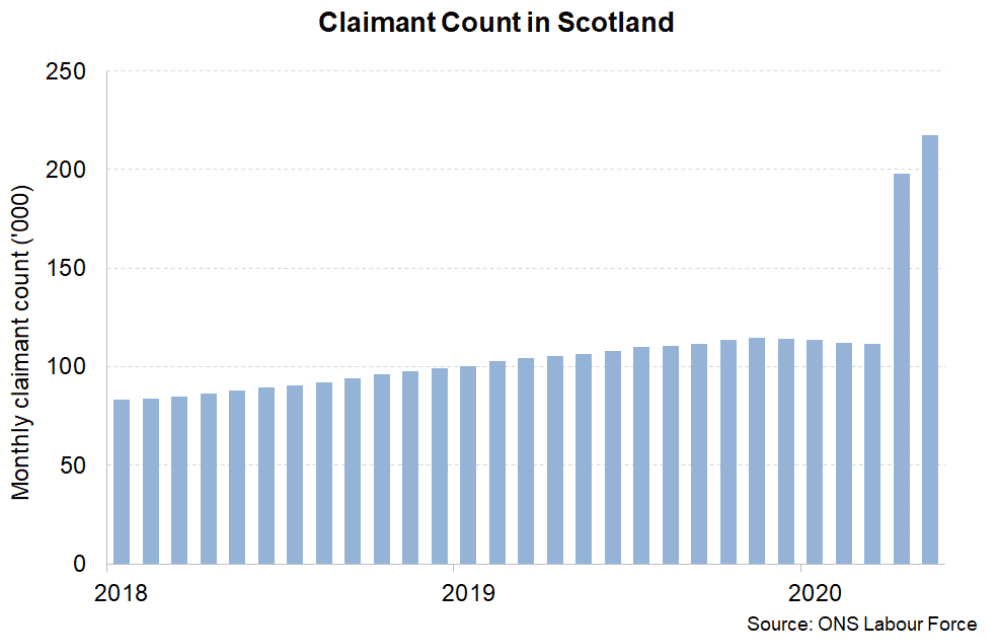
Figure 2 description
This figure shows the monthly claimant count in thousands. The count has increased from around 800,000 at the beginning of 2018 to around 110,000 by the start of the crisis. IT has then risen dramatically to 220,000 over the course of April and May 2020..
Experimental claimant count data for Scotland between April and May 2020, shows a 10% increase, taking the level to 218,000 and the rate to 7.8%. The experimental claimant count data covers claims for Jobseeker's Allowance and those claimants in the Universal Credit 'searching for work' conditionality. These suggest that unemployment in Scotland in May was closer to 187,000 (from 127,000 in April) with a rate at around 6.7%. We can expect to see unemployment rise each month, depending on what happens with workers currently furloughed (628,000 workers in Scotland up to 31 May).[6]
2.3 Economic prospects
We estimate a 33% fall in Scottish GDP over the months that the current distancing measures are in place (see Figure 1). These estimates are similar to those produced by the OECD as well as other organisations such as the Office for Budget Responsibility.
The outlook for the UK economy is increasingly pessimistic. The latest UK GDP data for March 2020 was down 5.8% compared to February (and down 2% over the first quarter of 2020). The average of independent forecasts for the UK suggests a fall of 8.6% in GDP.
The Bank of England scenario analysis (7 May) suggests that UK GDP could fall by 14% in 2020 with a bounce back to growth of 15% in 2021. Unemployment could rise to 8% in 2020 and remain elevated at 7% in 2021.
The Bank of England and the OBR have in recent analysis assumed a V-shaped recovery, that is, a short, sharp decline in economic activity followed swiftly by a rebound in growth within 12 months. As more economic data emerge, there is a growing recognition that a quick rebound in economic activity following the phasing out of lockdown may be unlikely.
The Scottish economy will recover from the current impacts of Covid-19, but the shape and speed of adjustment are uncertain. Although physical distancing measures are expected to be temporary in nature, there is potential for even short-term measures to have long-lasting impacts and become more structural.
The Scottish Government has undertaken modelling of illustrative scenarios. The modelling presents two illustrative scenarios for the economy, not forecasts or predictions, but scenarios that reflect key policy variables and potential recovery paths for the economy. The Scottish Government has undertaken modelling of illustrative scenarios. Figure 3 shows a 'V-Shaped Recovery' scenario, with a sharp fall in GDP and then a strong recovery; unemployment rises to 10% in late 2020, before returning to pre-pandemic levels after around a year.
There is still a significant amount of uncertainty over how the labour market may recover. For example, during the financial crisis, there was evidence of employees willing to accept pay cuts in order to maintain employment. Alternatively, firms may prefer to maintain wages to retain experienced staff in the short-term, whilst keeping fewer staff to cut costs.
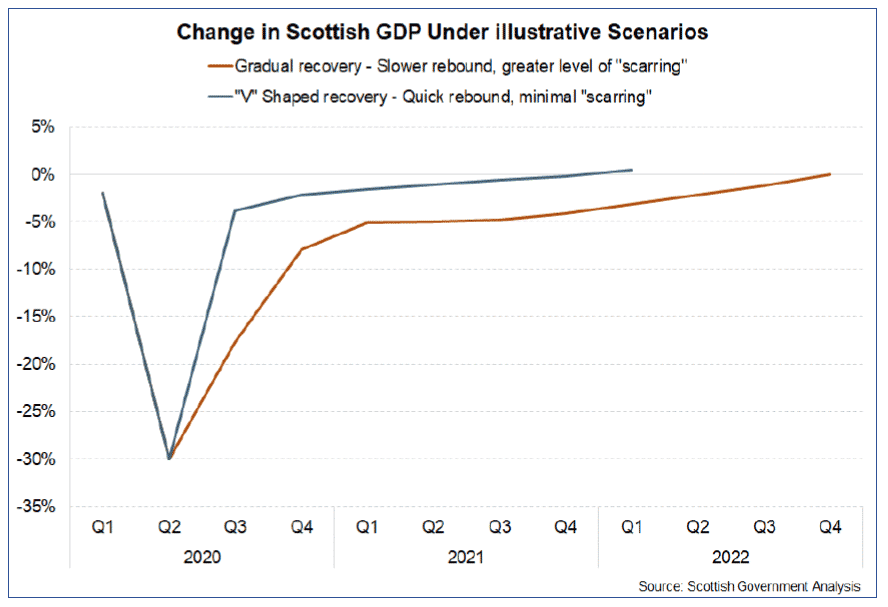
Figure 3 description
This figure shows two scenarios modelled by the Scottish Government for the future path of GDP in the medium term. The first, a v-shaped recovery sees GDP reach pre-crisis levels in early 2021. The second a gradual recovery, sees GDP reach pre-crisis levels in late 2022.
Figure 3 shows that, in the first scenario, 'V-Shaped Recovery', there is a swift recovery across all sectors, with minimal loss of productive capacity or scarring on the economy. In the second scenario, 'Gradual Recovery', a greater degree of scarring is assumed and sectors recover at different speeds as restrictions are gradually lifted.
Despite both scenarios having the same profile up to 2020 Q2, the medium-term pathway looks very different. In the 'Gradual Recovery' scenario, the slower rebound in demand causes the short-term downturn to be more protracted, and more importantly the greater degree of scarring means economic output does not recovery to pre-crisis levels until the start of 2023.
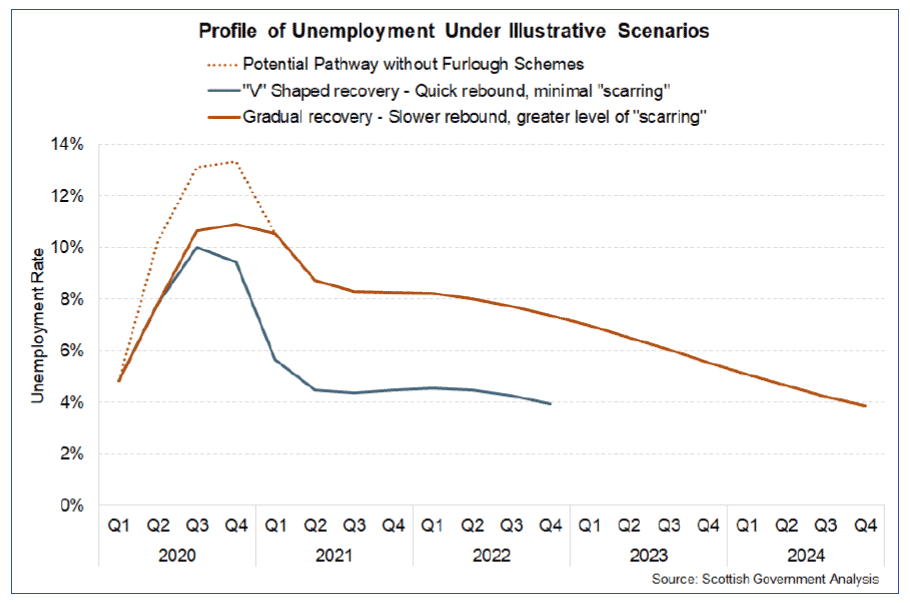
Figure 4 description
This figure shows three paths for unemployment. Under a v-shaped recovery it peaks at 10% in Q3 2020 before returning to pre-crisis levels in Q2 2021. Under the gradual recovery scenario it reaches a peak of 11% in late 2020 and does not reach pre-crisis levels until Q4 2024. A third path shows that without the furlough schemes, unemployment would peak at 13% and then follow the gradual recovery path.
Figure 4 also shows the impact the Job Retention Scheme could have on headline unemployment rates in Scotland. Even with the current levels of government fiscal support, in the absence of the scheme, it is estimated that unemployment could have reached around 14%. This is similar to what has already been seen in the US, where there is no equivalent scheme. Ultimately, the level of unemployment will depend on how many people currently furloughed become unemployed as the scheme is unwound. This highlights the importance of withdrawing the scheme gradually.
2.4 Assessment of factors affecting the economic recovery
There are a number of factors that are uncertain around the recovery and the medium-term outlook.
As the economy restarts, we will see a reversal of the output contraction for many parts of the domestic economy. Not all sectors will come back immediately, however, as external demand, consumer tastes and business models will have changed significantly in order to operate in a safe manner.
There may be a loss of productive capacity as the restrictions in economic activity continue and this will lengthen the recovery period. This may manifest itself in high unemployment and high rates of business failures and the scarring effects that these have on individuals and communities.
The crisis may also accelerate some structural changes that were already happening, such as a switch from high street retail to online.
The policy response to the economic shock, most notably the fiscal stimulus to support jobs and businesses, is already of a greater scale than that witnessed in the financial crisis. The unwinding of these support schemes will be critical to the recovery.
The cost of the support schemes means that the UK will run an unprecedented fiscal deficit in 2020. Despite the fiscal stimulus and support measures in place, businesses, households, organisations of all kinds and government will all emerge from the crisis with debt, and how this debt overhang is dealt with will have a substantial bearing on the speed of recovery.
The global nature of the crisis means that the recovery will depend on how other countries and trading partners also recover from the crisis.
Whilst the factors affecting the recovery are uncertain, there is clarity that the rapid pace and scale of collapse in economic activity that has been witnessed is the starting point for the recovery and the point of departure.
Commissioned Report by Dr David Skilling
We commissioned Dr David Skilling, an acknowledged expert in small, open advanced economies, to look at other countries' policy responses to the pandemic and identify possible lessons for Scotland. We are publishing his report alongside ours.
In summary, Dr Skilling's analysis is that the crisis will accelerate structural dynamics and lead to more enduring change than the global financial crisis of 2008, with increasing frictions on globalisation; pressures to localise supply chains; support for national champions; and restrictions in cross-border flows of capital and people. The role of government in the economy will grow, and new growth sectors will emerge while others decline sharply.
In response, he recommends that Scotland should:
- Increase investment in research and innovation
- Give new impetus to the upgrading of skills
- Reprioritise support towards strategic growth sectors - digital, life sciences, green tech, food and drink
- Grow state capacity to support and intervene in the economy
2.5 Potential impact of Brexit
Although the UK has left the EU, it is still able to benefit from most aspects of EU membership because it is in an implementation period during which pre-Brexit rights and obligations apply in almost all areas. Ending that period at the end of 2020, even with the type of basic deal the UK Government is pursuing, or worse still without a deal with the EU at all, will represent a significant additional downside risk to the trajectory of the economic recovery.
A full assessment was published by the Scottish Government in 2019,[7] which noted that tariffs and non-tariff barriers will clearly make it harder for Scottish businesses to trade with the EU, and will likely reduce the volume of trade. The sectors that appear most vulnerable include food and drink, chemicals, life sciences and other manufacturing sectors. Impacts are likely to be felt quickly, although longer-term there may be opportunities to explore alternative international markets and rebuild domestic supply chains. The level of regulatory alignment (e.g. via agreement on equivalence or mutual recognition) with EU standards is important in facilitating trade, not only with the EU, but also with non-EU countries where EU standards are widely accepted, such as financial services, chemicals, life sciences, creative industries and food and drink sectors.
Immediate and short-run effects will include:
- Introduction of non-tariff barriers to trade with the EU (and tariff barriers in a no deal outcome);
- Increased disruption to supply chains already experiencing challenges due to Covid-19; and
- Heightened uncertainty in some markets.
The combined impact of these effects on businesses that are already severely affected by Covid-19 could result in widespread business closures and job losses over and above those resulting from Covid-19 alone.
Scottish Government modelling[8] indicates that ending transition this year would result in Scottish GDP being between £1.1 billion and £1.8 billion lower by 2022 (0.7 to 1.1% of GDP), compared with ending transition at the end of 2022. That would be equivalent to a cumulative loss of economic activity of between nearly £2 billion and £3 billion over those two years. This will clearly hamper the economic recovery.
Looking to the longer term, in 2018, the Scottish Government published a discussion paper[9] on the impact of Brexit on migration and the specific Scottish impacts in terms of the population challenges we face as a nation.
Powers over immigration are reserved to the UK Government under the Scotland Act 1998 but inward migration brings benefits to Scotland's demography, economy and society. The demographic benefits of migration are made clear in projections from NRS and ONS of Scotland's future population growth.
There are projected to be more deaths than births in every year going forward. Each year for the next 25 years, all of Scotland's population growth is projected to come from migration. UK Government policy and the impact of Brexit mean that international migration to Scotland is projected to decline, further inhibiting Scotland's population growth.
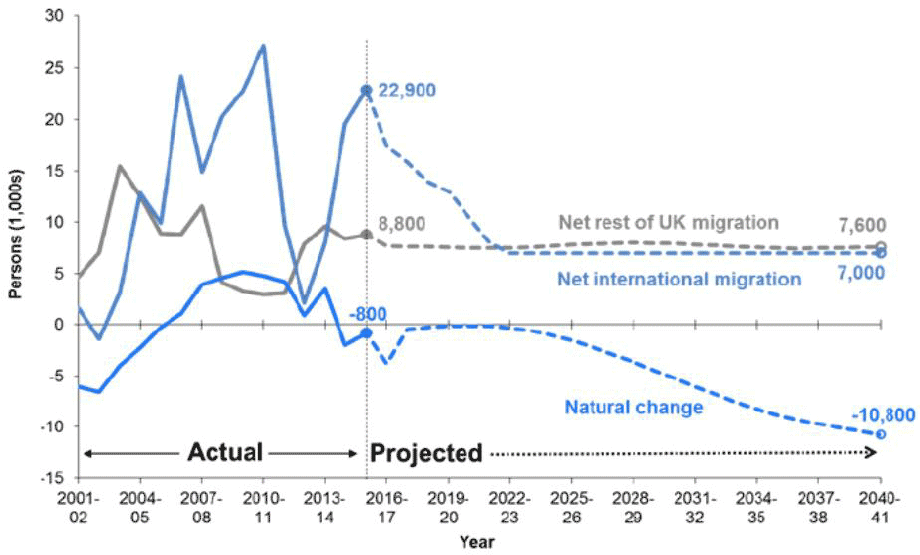
Figure 5 description
This figure shows the historical changes in Scotlands population since 2001 and future estimates of annual levels if net migration from the rest of the UK, net migration from other sources and the underlying natural change. But 2040, the natural change is an annual loss of -10,800. This is projected to be mitigated by net migration of 7,600 people from the rest of the UK and 7,000 people from elsewhere, primarily the EU. The diagram illustrates the point that in the absence of international migration, the Scottish population is expected to fall.
The age profile of the population will also change. The proportion of the population of state pension age will increase by 25% in the coming years as the 'Baby Boomer' generation reaches retirement. People aged 75 and over are projected to be the fastest growing age group in Scotland, increasing by 79% over the next 25 years.
The prospect of people in Scotland living longer, healthier lives is welcome, and increasingly many people of state pension age continue to work and contribute to the economy in that way. It is also the case that people in the oldest age categories become more likely to need access to health and social care services to support them in old age. Those essential public services will require a buoyant working age population with appropriate skills that over the last decade has been supported by inward migration from the EU that may be restricted following Scotland's exit.
Contact
Email: AGER@gov.scot
There is a problem
Thanks for your feedback